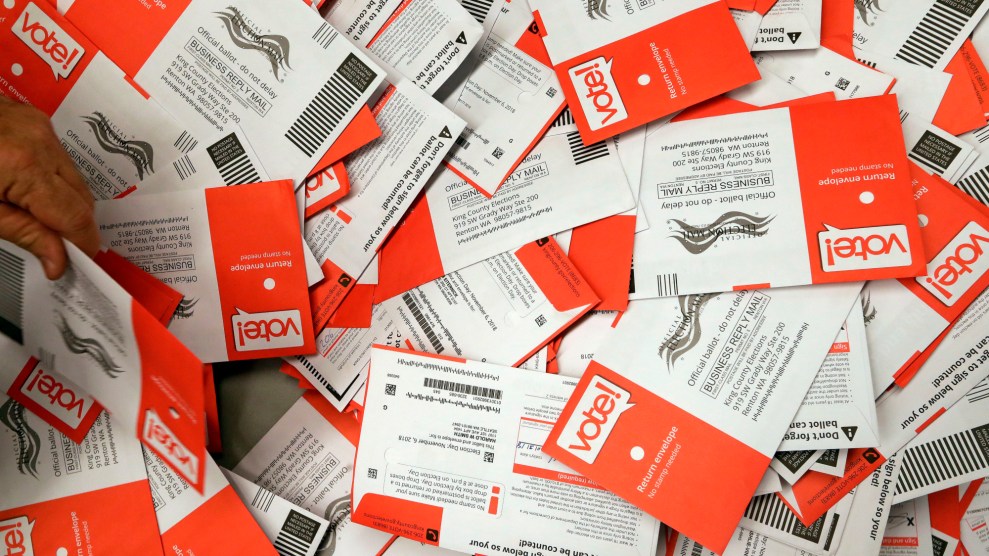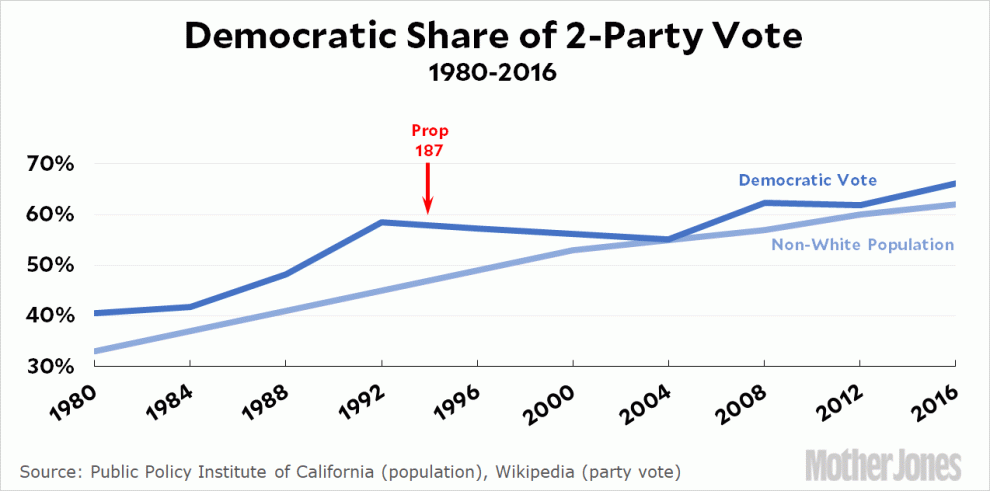
Mother Jones illustration; Getty
Last summer, the Texas political universe was rocked by an audio tape, secretly recorded by a conservative activist named Michael Quinn Sullivan. In a closed-door meeting with Sullivan at the state Capitol, the Republican speaker of the House, Dennis Bonnen, insulted Democratic colleagues in crude personal terms and offered the activist coveted press passes for the next session of the legislature if his organization, Empower Texans, would agree to back primary challenges against incumbent members of his party—a proposed quid pro quo that led to an investigation by the Texas Rangers. For those unconcerned with legislative chicanery, perhaps the most revealing exchanges had to do with the state’s political landscape.
“With all due respect to Trump—who I love, by the way—he’s killing us in urban-suburban districts,” Bonnen confided. According to Bonnen, Trump was trailing by 15 points in one critical state House district the party had polled. The incumbent state representative was barely staying afloat. “A Democrat house will produce a Democrat congressional map,” Sullivan said later in the recording. “And then that will be the end of the republic.”
“End of the republic” might be an overstatement, but the stakes are plenty high: If Bonnen’s numbers (and more recent public polling) are even close to accurate, Democrats have a real chance of winning a majority of seats in the state house of representatives for the first time since 2002—a breakthrough that would give the party not just the power to block conservative legislation in the nation’s largest red state, but a say in the redistricting process that will shape Texas politics for years to come. The fight for control of the Texas House of Representatives might be the most significant down-ballot election in America this fall.
Even with a tight presidential election, a US Senate race, and 10 targeted congressional seats, Texas Democratic party spokesperson Abhi Rahman calls flipping the state House “our top strategic priority.”
The math is simple. Democrats need to pick up nine seats to take control of the chamber. That’s the exact number of currently Republican-held districts that Beto O’Rourke carried during his 2018 Senate bid. (They also need to defend the 12 seats they flipped that year—no easy task.) Overall, Democrats are targeting nearly two dozen seats, most of them based in the diverse suburbs around Houston, Dallas, and Fort Worth, where the party has made huge gains over the last four years.
If you want to understand what breaking the redistricting monopoly in Texas would mean for state and national politics over the next decade, just consider what that monopoly has meant for the last two. Texas is not the only state with an extremely partisan map, but it’s the biggest and, historically, the messiest. In 2003, just two years after new maps had gone into effect that gave Democrats a slight majority in the congressional delegation, then–House Majority Leader Tom DeLay, a Republican who would later be sentenced to three years in prison for a campaign money laundering scheme, pushed through an unprecedented, mid-decade round of redistricting that wrenched control of the congressional delegation from the Democrats. (When Democratic state lawmakers fled to Oklahoma to prevent a quorum in the legislature, DeLay enlisted the Federal Aviation Administration to help find them.)
After Republicans took huge majorities in both chambers of the state legislature and the congressional delegation in the tea party wave of 2010, Republican map-makers tried to make that high-water-mark permanent through an extreme partisan and racial gerrymander. The party gained a two-to-one advantage in its congressional delegation, with only one nominal swing seat. In perhaps the most egregious example of the lengths Republicans went to, Austin, a heavily Democratic city that’s now home to nearly a million people, was split into six districts—five of which favored Republicans. (Austin’s only solidly Democratic district extends all the way to San Antonio, in a clumsily drawn attempt to cluster together as many Latino Democratic voters as possible.) The 2011 redistricting process set off a seven-year legal fight. One federal judge ruled that the state GOP’s map-making process was “discriminatory at its heart” because of the way it reduced the voting power of Latino voters. But the Supreme Court sided with the state in 2018.
By that point, population growth and partisan shifts had in some ways caught up with these efforts—the gerrymandering was too aggressive, it turned out, kind of like building a flood wall at low tide. A congressional map that was supposed to produce just one competitive race now has a dozen. But it was a valuable tool for consolidating power while it lasted. In the statehouse, Republicans have used their near-supermajority over the last decade to push through legislation dramatically curtailing abortion rights, suppressing voting rights, and punishing cities that offer sanctuary to undocumented immigrants.
The disparity was all the more notable given the demographics behind the state’s population growth. Texas picked up four new congressional seats after the 2010 census because of its population boom in the preceding decade. “About 90 percent of the state’s population gain was non-white,” says Michael Li, a senior counsel at New York University School of Law’s Brennan Center for Justice. “Yet they didn’t draw any minority opportunity seats.”
Over the last decade, those demographic trends have continued. The state is poised to add three more seats (barring a major census undercount), due almost entirely to a growth in its population of people of color. How much voting power residents of color will have for the next decade depends in large part on who wins power in November.
“We know who are the drivers of the population growth,” says Royce Brooks, the executive director of Annie’s List, an organization that trains and supports pro-choice women candidates in Texas and that has backed candidates in 14 of the targeted districts. “It’s communities of color, it’s young people. And if we have a Democratic state house, those seats would be drawn in a way that reflects the drivers of that growth. If we continue to have a right-wing Republican state house, then they won’t.”
According to Li, the clearest impact Democrats can have on the process is with the federal maps. If the Republican state senate and Democratic state house can’t agree on new congressional lines, then a court will draw them up. That would likely produce a far more equitable outcome than what Tom DeLay or the 2011 process produced. (To get a bit speculative, a map that truly reflected Democrats’ support statewide would net the party about five more seats and Republicans five fewer seats than they currently hold—a 10-vote swing in the partisan makeup of Congress.) The process for state legislative maps is a bit different because if the legislature is deadlocked, the process goes to a five-member board, which would be comprised mostly of current Republican officeholders. But control of the lower chamber would allow Democrats to pass their own redistricting plans, which could be used to support a legal challenge to a discriminatory map.
All of this sounds a little inside baseball. But the anti-Trump resistance movement that has helped power progressive victories over the last few years has shown a penchant for such fights. Indivisible, the national grassroots organization, evolved from a Google Doc offering insider tips on how to pressure your member of Congress. Activists have embraced causes like abolishing the filibuster and court-packing and studied up on the rules of Senate procedure. But redistricting is not just a focus at the grassroots level. The Texas House Democratic Campaign Committee brought in $3.6 million over the last three months—a massive haul for the down-ballot organization. And in a state where Democrats have traditionally been starved of outside support, the fight for the chamber has drawn national attention. The super-PAC Forward Majority announced in September it was spending $6.2 million to flip the Texas house. Not long after, a coalition of organizations, including former Attorney General Eric Holder’s National Democratic Redistricting Committee, said it would spend $1.1 million to help 11 Democratic challengers.
Swing-district candidates I spoke to are leaning into the redistrict fight—it’s been a source of money and volunteers, and, in addition to staple issues like education funding and Medicaid expansion, part of the pitch to voters.
“We’ve had volunteers from across the country making calls for us,” says Lorenzo Sanchez, a 34-year-old real estate agent who is trying to flip a seat in the Dallas suburbs and who supports the creation of an independent redistricting commission to handle the process in the future. “We have postcards coming in. Even before we won the runoff, we had already received donations from every single state in the country—for a Texas house race!”
Jeff Leach, Sanchez’s opponent, offers a glimpse of the inflection point at which the Texas Republican Party has found itself. Leach was a founding member of the arch-conservative Texas Freedom Caucus, which has been described by Texas Monthly as “a kind of far-right frat house where nuance and compassion go to die.” He opposed Medicaid expansion and sponsored a bill that would have criminalized all abortions. After winning his 2018 race by just three points, he quit the group and apologized for his abortion legislation, telling the Dallas Morning News that his own bill would have subjected women who get an abortion to the death penalty. “I did not understand the criminal implications on the woman,” he said. Oops?
Leach’s seat would have been considered safe just a few years ago. But Collin County, where Sanchez is running, is emblematic of the changing political tides in Texas. As recently as 2014, Abbott carried the county by 33 points. Trump won it by 17 points in 2016. Ted Cruz beat O’Rourke there by just six points in 2018. This year, polls show it’s a toss-up. Sanchez saw the changes firsthand that cycle as a volunteer with the Resistance group Swing Left and later for both O’Rourke and now-Rep. Colin Allred, who won a formerly Republican congressional seat in 2018.
“We know how dangerous it has been for decades here in Texas, of not being a player in the room, not even being able to see when they’re getting drawn and how they’re being drawn,” Sanchez says of previous redistricting efforts. “And we just get presented with the maps and have to accept them. The situation if we take back the Texas House has national implications. The reason why people are so fired up here in Collin County is because we know we can really change the course of our national politics starting in our very own backyard this election cycle.”
In the Houston suburbs, it’s the same story, albeit with a far different Republican incumbent. Unlike Leach, Rep. Sarah Davis has cultivated a reputation as a moderate during her decade in the state house. She opposed a bathroom bill that targeted transgender students. She was the first member of her caucus to back same-sex marriage. She once fought back a primary challenge—supported by the Republican governor—from an anti-vaxxer. And she is the only Republican in the state legislature who supports abortion rights—a stance that once again this year netted her the endorsement of Planned Parenthood.
Voters have rewarded Davis for these stands. Two years ago, as O’Rourke routed Cruz in her suburban district by 21 points, Davis was reelected by six. This year, though, the stakes are a bit different. Critics there have dubbed her “the Susan Collins of Texas,” a nod to the Maine senator whose occasional deviance from the party line has, in the eyes of voters, been overshadowed by her support for a Republican Senate majority. When Democrats were shut out of power, Davis was seen by some as an ally on the inside. But she and her fellow incumbents aren’t just running against the familiar political headwinds this year; they’re running against the future.
“I always say, ‘I understand where you’re coming from, but do you like Sarah Davis enough to give Gov. Greg Abbott the House and control over Texas for a decade?’’” says her Democratic opponent, Ann Johnson, of her conversations with liberal-leaning voters who have supported the incumbent in the past.
“And I don’t find anybody that says yes.”












